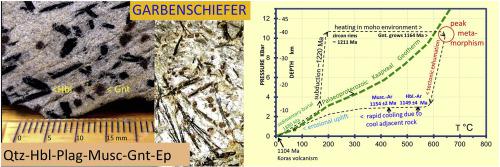Geoscience Frontiers ( IF 8.9 ) Pub Date : 2019-06-23 , DOI: 10.1016/j.gsf.2019.06.004 Valby Van Schijndel , David H. Cornell , Robert Anczkiewicz , Anders Scherstén

|
Metamorphic provinces such as the ∼1 Ga Grenvillian, ∼400 Ma Caledonide and Triassic Qinling Provinces often contain rocks with high-pressure assemblages such as eclogites, which formed at mantle depths in subduction zones. These are evidence of the accretion of terranes by subduction of oceans and collision to form large tectonostratigraphic provinces. The Mesoproterozoic Namaqua-Natal Province comprises a number of terranes thought to have been assembled by plate-tectonic processes, but they have generally yielded metamorphic pressures below 5 kbar, corresponding to <20 km, crustal depths, lacking evidence for subduction processes. The Kaaien Terrane in the Namaqua Front contains two large garbenschiefer units with the unusual paragenesis garnet-hornblende-epidote-white mica-plagioclase-ilmenite-quartz. Their protoliths are graywackes influenced by andesitic volcanism during their deposition at ∼1870 Ma, in a passive margin of the Rehoboth Province or Kaapvaal Craton. Prograde garnet growth dated at 1165 ± 5 Ma culminated in peak metamorphic conditions of 645 ± 30 °C and 10.4 ± 0.7 kbar, corresponding to 40 km depth. This is attributed to subduction of these rocks before collision between the overriding arc-related Areachap Terrane, the Kaaien Terrane and the Kaapvaal-Rehoboth cratonic block during the Namaqua orogeny. Exhumation of the garbenschiefer slabs was followed by rapid cooling, as the 1143 ± 5 Ma argon dates of hornblende and white mica, with closure temperatures ∼540 °C and ∼440 °C respectively, are the same within error. This was probably due to tectonic juxtaposition of the garbenschiefer slab with much cooler rock units. The exhumation was accommodated along the Trooilapspan-Brakbosch Shear Zone due to ongoing transpression. Other components of the Namaqua Front have distinctly different P-T-t paths, exemplified by greenschist metamorphism in the 1300 Ma Wilgenhoutsdrift Group, and medium-pressure metamorphism in the Areachap Terrane. They were juxtaposed by late-tectonic uplift and transpressional movements. The ∼40 km depth of garbenschiefer peak metamorphism is the deepest yet found in the Namaqua-Natal Province and strengthens the plate tectonic model of accretion by collision of terranes at the end of a Wilson cycle. The high pressure paragenesis of the garbenschiefer was preserved due to its location in the Namaqua Front, whereas most other parts of the Namaqua-Natal Province were overprinted by 1100–1020 Ma thermal events after the collision events.
中文翻译:

南非纳马夸前线的加本施费尔中元古代碰撞,深埋和快速发掘的证据
变质省如〜1 Ga格伦维连,〜400 Ma Caledonide和三叠纪秦岭等省通常含有高压组合的岩石,如榴辉岩,形成于俯冲带的地幔深度。这些是通过俯冲海洋和碰撞形成大型构造地层省份而增加地层的证据。中生代纳马夸-纳塔尔省包括许多被认为是通过板块构造过程组装的地体,但它们一般产生的变质压力低于5 kbar,相当于<20 km,地壳深度,缺乏俯冲过程的证据。纳马夸前线的Kaaien Terrane包含两个大型garbenschiefer单元,具有不寻常的共生石榴石,角闪石,迷幻类,白色云母,斜长石,钛铁矿-石英。它们的原生石是灰泥岩,在Rehoboth Province或Kaapvaal Craton的一个被动边缘,于1870年Ma沉积期间受到安山岩火山作用的影响。在645±30°C和10.4±0.7 kbar的峰值变质条件下,石榴石的生长在1165±5 Ma达到顶点,对应于40 km的深度。这是由于在纳马夸造山运动中与弧相关的Areachap Terrane,Kaaien Terrane和Kaapvaal-Rehoboth克拉通块体之间的碰撞之前,这些岩石被俯冲了。garbenschiefer板的掘出之后进行快速冷却,因为角闪石和白云母的1143±5 Ma氩日期分别具有约540°C和约440°C的封闭温度,这是有误差的。这可能是由于具有较冷岩石单元的garbenschiefer板块的构造并置所致。由于持续的压迫,尸体被安置在Trooilapspan-Brakbosch剪切带沿线。Namaqua锋的其他部分具有明显不同的PTt路径,例如1300 Ma Wilgenhoutsdrift组的格林斯主义者变质作用以及Areachap Terrane中的中压变质作用。它们与晚期构造隆升和压移运动并列。Garbenschiefer峰变质的约40 km深度是纳马夸-纳塔尔省最深的发现,并加强了威尔逊循环结束时因地体碰撞而形成的板块构造增生模型。garbenschiefer的高压共生因其位于Namaqua Front而得以保留,



























 京公网安备 11010802027423号
京公网安备 11010802027423号